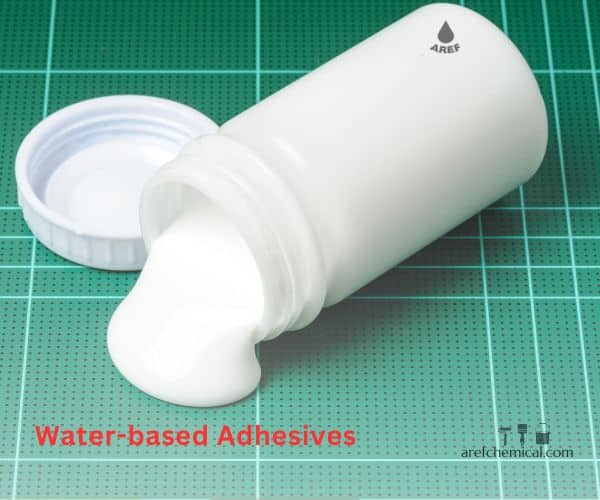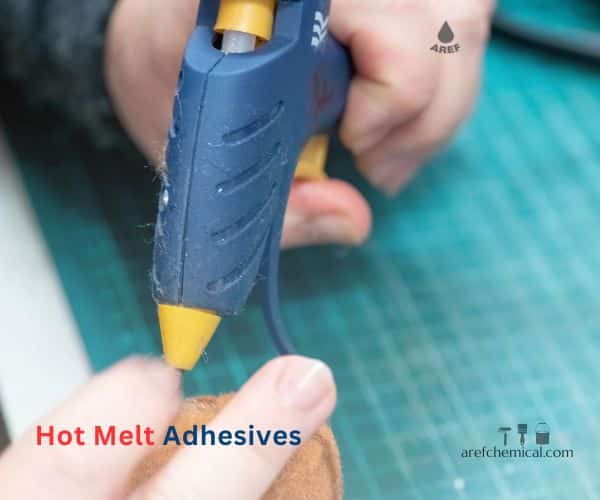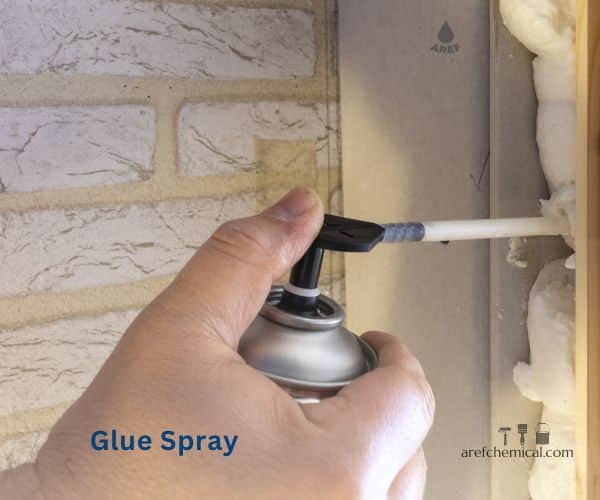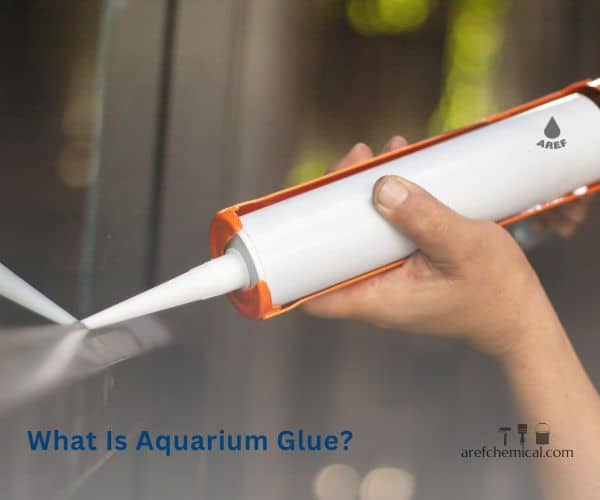Adhesives are among the very important and practical materials in various industries, with their main function being to create a strong bond between different surfaces. Adhesives are categorized into different types based on their composition, application, and specific characteristics. This classification includes natural and synthetic adhesives, industrial adhesives, and two-component adhesives. Each of these types of adhesives is used according to the specific needs of the industry, home projects, handicrafts, and repairs. Therefore, understanding the different types of adhesives and their characteristics can help in making the right and efficient choice for various applications. Have you ever thought about the wide variety of adhesives and their different applications? In this article, we aim to introduce you to the fascinating world of different types of adhesives.
What is glue and how does it work?
Adhesives play an important role in our daily life. From simple home repairs to complex industrial projects, adhesives are everywhere. The adhesive is a substance that can connect two surfaces together. This connection can be made through adhesion (sticking to surfaces) and cohesion (internal bonding of adhesive molecules). Adhesives are usually made of polymers, which can be natural or synthetic.
A brief history of glue:
The use of glue is as old as human history. Archaeologists have found evidence of the use of natural adhesives such as tree gum and resins in ancient artifacts. With the passage of time and the progress of chemistry, synthetic adhesives with higher efficiency were produced, and they are used in various industries today.
General classification of glue types:
- Blue base adhesives
- Solvent adhesives
- Reactive adhesives
- Hot melt adhesives
- Natural adhesives
In the following, we will take a closer look at each of these categories.
Water-based adhesives
Choosing the right adhesive is more than a simple decision. This selection requires a deep understanding of the nature of the material, environmental conditions, and project requirements. An adhesive that works great for one application may be completely unsuitable for another. Blue-based adhesives are one of the most popular and widely used types of adhesives. These adhesives are composed of polymer particles suspended in water. When the water evaporates, the polymer particles stick together and form a sticky layer.
Advantages:
– Environmentally friendly
– No smell
– Washable with water (before drying)
– Safe for children to use
Disadvantages:
– Less resistance to moisture
– Relatively long drying time
Applications:
– Pasting paper and cardboard
– Crafts and art projects
– Binding and bookmaking
Examples:
– Paper glue
– Latex glue
Solvent adhesives
Solvent adhesives are prepared by dissolving polymers in organic solvents. These adhesives establish a bond by evaporating the solvent.
Advantages:
– Strong adhesion
– Good resistance to moisture and temperature
– Fast drying time
Disadvantages:
– Strong and sometimes unpleasant smell
– High flammability
– Importance of Adequate Ventilation During Use
Applications:
– Shoe and leather industries
– Car repairs
– Construction industry
Examples:
– Neoprene glue
– Contact adhesive
– PVC glue
Reactive adhesives
These types of adhesives harden through a chemical reaction. They usually consist of two or more components, which after combining, the chemical reaction begins.
Advantages:
– Very high strength
– Excellent resistance to heat and chemicals
– The ability to fill the gap between levels
Disadvantages:
– Limited working time after mixing the components
– The need for accuracy in the composition of the ratio of components
– More expensive than any other kind of glue
Applications:
– Aerospace industries
– Construction and repair of boats and ships
– Metal connections in heavy industries
Examples:
– Epoxy glue
– Polyurethane glue
– Cyanoacrylate glue (instant glue)
Hot melt adhesives:
Hot melt adhesives are solid polymers that melt with heat and establish a connection after cooling.
Advantages:
– Very fast drying time
– No need for halal and environmentally friendly
– Reusability by heating
– High adhesion speed
– Can be used on different surfaces
Disadvantages:
– The need for special equipment to use (hot glue gun)
– Limited thermal resistance
– Less adhesion than some other types
Applications:
– Packaging
– Wood and furniture industries
– Crafts and decorations
– Temporary connections in various industries
Examples:
– Thermal glue (used in glue gun)
– Adhesives used in the packaging industry
Be careful of burns when using a hot glue gun.
Natural adhesives:
Natural adhesives are extracted from plant or animal sources. Although they are less commonly used today, they are still useful in some applications.
Advantages:
– Fully compatible with the environment
– Non-toxic and safe to use
– renewable
Disadvantages:
– Less resistance than synthetic adhesives
– Limited lifespan
– Sensitivity to humidity and temperature
Applications:
– Traditional binding
– Restoration of works of art
– Making wooden musical instruments
Examples:
– Starch glue
– Srisham (animal glue)
– Casein glue (from milk)
What is wood glue?
Wood glue is one of the most widely used types of glue in wood and craft industries. This glue is blue-based and usually made of polyvinyl acetate (PVA).
Features:
– It is white in color and becomes transparent after drying.
– It has good resistance to moisture (of course, not to the extent of complete immersion in water).
– It is environmentally friendly and non-toxic.
Applications:
– Connecting wooden parts in furniture making
– Crafts and art projects
– Pasting paper and cardboard
Important note: for a better connection, the wood surfaces must be clean and free of dust.
What is fabric glue?
Fabric glue is designed to connect all kinds of textiles. This glue can be water-based or solvent-based.
Features:
– It is flexible and does not crack when the fabric moves.
– Resistant to washing (in quality types)
– In some cases, ironing is required to activate the adhesive.
Applications:
– Clothing and fabric repair
– Sewing without the need for needles and thread
– Making fabric crafts
Important note: Be sure to read the instructions on the package before use, as the method of use may vary.
What is the use of super glue or cyanoacrylate glue?
Super glue is a very strong instant adhesive made from cyanoacrylate polymers.
Features:
– Very fast drying time (several seconds to several minutes)
– Extremely high adhesive strength
– Good resistance to moisture and chemicals
Applications:
– Urgent and small repairs
– Gluing plastic, metal, wooden parts, and even some tires
– Making models and replicas
Important note: Be very careful when using superglue as it sticks to the skin quickly.
What is the use of epoxy glue?
Epoxy glue is a two-component glue that after the two components are mixed, the chemical reaction starts and the glue hardens.
Features:
– Very high strength
– Excellent resistance to moisture, heat, and chemicals
– Ability to fill seams and gaps
Applications:
– Repairs of metal, glass, ceramic, and some plastic parts
– Construction and repair of boats and ships
– Industrial and construction applications
Important note: accuracy in mixing ratio of two components is very important. Also, you have limited working time after mixing.
Glue spray
The adhesive spray is a type of adhesive that comes in spray form and is usually used for large surfaces.
Features:
– Uniform and fast coverage of large surfaces
– Quick drying
– Ability to stick light materials such as paper, fabric, and foam
Applications:
– Furniture industry (gluing sponge and fabric)
– Interior decoration
– Artistic and exhibition works
Important note: When using adhesive spray, be sure to work in a well-ventilated environment.
Polyurethane glue
Polyurethane adhesive is a strong and flexible adhesive that can be one or two components.
Features:
– Excellent resistance to moisture and chemicals
– High flexibility
– Good adhesion to different materials
Applications:
– Automotive industry
– Construction (sealing and sealing)
– Shoe and leather industries
Important note: Polyurethane adhesives usually react with moisture in the air, so they must be stored in tightly closed containers.
What is aquarium glue?
Aquarium glue is a type of transparent and flexible glue that is specifically designed for use in aquariums and wet environments.
Features
– They are very resistant to water and do not leak or damage the structure of the aquarium.
– Aquarium adhesives are usually non-toxic to ensure the health of fish and other aquatic creatures.
– Aquarium glue effectively connects glass, plastic, and other materials.
– After drying, the aquarium glue becomes transparent and reduces the effects of the compounds used in the aquarium.
– After drying, it maintains its flexibility and is resistant to pressure and temperature changes.
This type of glue is especially used for making, repairing, or creating decorations in aquariums. When using it, it is important to follow the manufacturer’s instructions carefully.
Types of glue based on application
In this section, we look at different types of glue
Construction adhesives:
o Ceramic tile adhesives
o Concrete adhesives
o Insulation adhesives
Industrial adhesives:
o Epoxy adhesives
o Cyanoacrylate adhesives (instant adhesives)
o Polyurethane adhesives
o Thermal adhesives
o Silicone adhesives
- Homemade glues:
o Multipurpose adhesives
o Wood glues
o Liquid glue
o Paper and cardboard adhesives
Types of glue based on ingredients:
- Natural glues (such as wood glue, animal glue)
Synthetic adhesives (such as epoxy, and polyurethane adhesives)
Each type of glue has its own characteristics and uses depending on the material that is supposed to be glued together.
What will be the future of the glue industry?
The adhesive industry is always evolving and developing. The world of adhesives is a dynamic and evolving world. As technology advances and awareness increases about specific needs in various industries, we can expect future adhesives to be more efficient, safer, and more environmentally friendly. Some of the future trends in this industry are:
– Development of biodegradable adhesives
– Smart adhesives with controlled separation
– Nano adhesives with special properties
– Adhesives inspired by nature (such as gecko adhesive)
In conclusion, it must be said that the world of adhesives is very wide and diverse. By knowing the types of glue and the characteristics of each, you can choose the best option for each application. Whether for everyday household tasks or complex industrial projects, there is always an adhesive to meet your needs.
Choosing the right glue depends on what factors?
To choose the best glue, you should pay attention to the following factors:
- Type of materials to be connected
- Environmental conditions (temperature, humidity, contact with chemicals)
- Required strength
- Desired drying time
- Safety and environmental considerations
Safety tips for using adhesives
– Always read the product label.
– Work in a well-ventilated environment.
– Avoid contact with skin and eyes.
– Keep adhesives out of the reach of children.
– Use special containers to store glue.
conclusion
From simple water-based adhesives to complex industrial formulations, each plays a unique role in daily life and various industries. Continuous advances in science and technology have opened new horizons in the adhesive industry. From nano adhesives to biodegradable adhesives, the future of this industry promises innovative solutions to the challenges ahead. As a consumer or professional, having sufficient knowledge about the types of adhesives, their properties and applications will make a significant difference in the outcome of your projects. Also, paying attention to safety and environmental points is vital not only for health but also for preserving the environment.
Frequently asked questions
- How do you choose the right glue for your work?
First Pay attention to the material you want to use glue. Consider environmental conditions such as temperature and humidity. Think about the amount of strength required. Specify the desired drying time. Don’t forget safety and environmental considerations.
- Why do some adhesives not work well?
– Surfaces may be dirty, greasy or wet. The glue may have expired. The wrong adhesive may have been used for that particular application. The ambient temperature may not be suitable for optimal performance of the adhesive.
- How to increase the life of adhesives?
Store the adhesives in a cool and dry place. Close the lid of the glue container tightly after each use. Prevent water-based adhesives from freezing. Keep two-part adhesives separate until use.
- Can the dried glue be softened again?
Some water-based adhesives can be re-softened by adding water. Hot melt adhesives can be re-softened by heating.
Most reactive adhesives cannot be softened after hardening.
- How to remove excess glue from different surfaces?
For water-based adhesives: they are usually removed with warm water and soap.
For solvent adhesives: use suitable solvents such as acetone or alcohol.
For super glue: use acetone or special cleaning solutions for super glue.
For epoxy adhesives: Wipe with alcohol before fully hardening. Once hardened, they usually have to be removed mechanically (sanding or shaving).
- Do all adhesives work underwater?
No, only special adhesives are designed for underwater use. These adhesives are usually of the epoxy or polyurethane type and are specifically formulated for underwater applications.
- Why do some adhesives need to be mixed?
Two-component adhesives, such as epoxy, are composed of two separate materials that, when mixed together, initiate a chemical reaction and harden the adhesive. This method makes it possible to create very strong links.






![Features of the computer color tint machine [advantages, how it works, main components, purchase tips]](https://www.arefchemical.com/wp-content/uploads/2025/02/Features-of-the-computer-color-tint-machine-150x150.webp)

13 Responses
great
https://arefchemical.ir/%D8%B1%D9%86%DA%AF-%D8%AA%D8%A7%DA%A9%DB%8C%D8%AF%DB%8C/
oh my God
https://behdama.com/%d9%81%db%8c%d9%84%d8%aa%d8%b1-%d9%be%da%a9%db%8c%d8%ac/
thanks
https://tavatranslation.com/%d8%b1%d9%88%d8%b4-%d9%85%d9%87%d8%a7%d8%ac%d8%b1%d8%aa-%d8%a8%d9%87-%d8%aa%d8%b1%da%a9%db%8c%d9%87/
ya modil
https://qomtamirat.com/
you are right
https://daroosf.com/%D9%88%DB%8C%D8%AA%D8%A7%D9%85%DB%8C%D9%86-%D8%AF%DB%8C-%D8%AF%D8%B1-%DA%A9%D9%88%D8%AF%DA%A9%D8%A7%D9%86/
i agree
https://daroosf.com/%D9%85%DA%A9%D9%85%D9%84-%D8%A7%D9%86%D8%B1%DA%98%DB%8C-%D8%B2%D8%A7/
yah man
https://daroosf.com/%D9%85%DA%A9%D9%85%D9%84-%D8%A8%DB%8C%D9%88%D8%AA%DB%8C%D9%86/
ya mobayyen
https://daroosf.com/%D9%85%DA%A9%D9%85%D9%84-%D8%B2%DB%8C%D9%86%DA%A9/
well done
https://daroosf.com/%D8%AA%D8%A8-%D8%AF%D9%86%DA%AF%DB%8C/
https://daroosf.com/%D9%85%DA%A9%D9%85%D9%84-%D8%B1%DB%8C%D8%B2%D8%B4-%D9%85%D9%88/
ya amanal khaefin
https://daroosf.com/%D9%85%D9%88%D8%B2%D8%8C-%D9%85%DB%8C%D9%88%D9%87-%D8%B4%D9%85%D8%A7%D8%B1%D9%87-%DB%8C%DA%A9-%D9%88%D8%B1%D8%B2%D8%B4%DA%A9%D8%A7%D8%B1%D8%A7%D9%86-%D8%AC%D9%87%D8%A7%D9%86/
sobhanallah
https://daroosf.com/%D9%85%D9%88%D8%B2%D8%8C-%D9%85%DB%8C%D9%88%D9%87-%D8%B4%D9%85%D8%A7%D8%B1%D9%87-%DB%8C%DA%A9-%D9%88%D8%B1%D8%B2%D8%B4%DA%A9%D8%A7%D8%B1%D8%A7%D9%86-%D8%AC%D9%87%D8%A7%D9%86/
Paying attention to safety and environmental considerations is crucial for protecting both health and the environment.